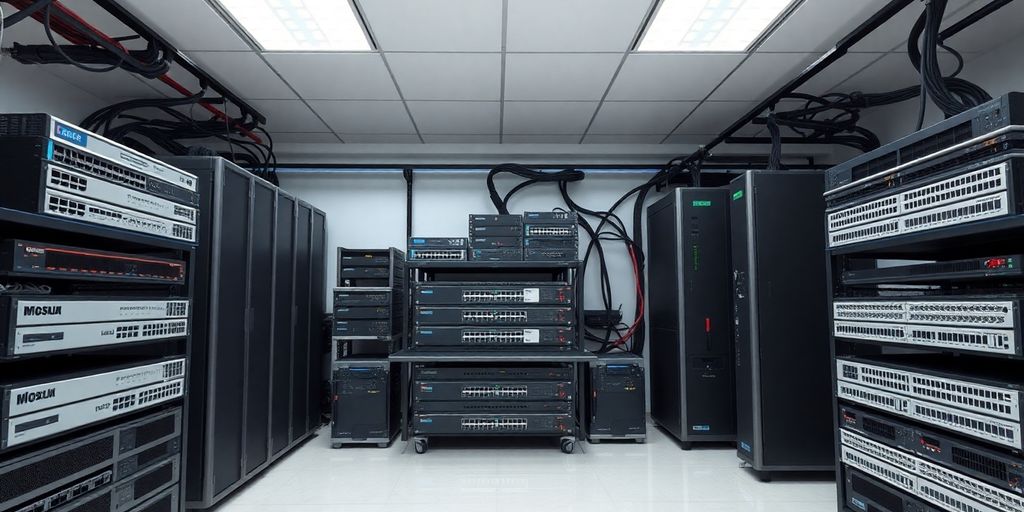Virtual communication is changing fast, and conferencing is at the heart of this shift. With technology growing by leaps and bounds, the way we meet and talk online is looking very different. From AI helping us run meetings to virtual reality making things feel more real, the future of conferencing is exciting and a bit unpredictable. As we step into 2025, it’s clear that these tools are not just add-ons but essential parts of how we connect, work, and share ideas globally.
Key Takeaways
- AI is making conferencing smarter and more efficient.
- Virtual reality is set to make meetings more immersive.
- Cloud solutions are making it easier to connect from anywhere.
- Security in virtual meetings is more important than ever.
- The demand for virtual communication tools is growing rapidly.
The Evolution of Conferencing Technology

AI Integration in Conferencing
AI is not just a buzzword anymore; it’s reshaping how we connect virtually. Imagine having a virtual assistant that not only schedules your meetings but also summarizes them. AI is making this a reality by offering features like real-time transcription and smart meeting summaries. These tools help participants focus on the conversation rather than taking notes. AI’s role in video conferencing is set to redefine productivity by providing insights and recommendations during meetings.
The Rise of Virtual Reality Meetings
Virtual Reality (VR) is stepping beyond gaming and entertainment into the corporate world. VR meetings offer a sense of presence that traditional video conferencing lacks. Participants can interact with 3D models, making discussions more engaging. It’s like being in the same room without the travel. As VR technology becomes more affordable, expect more businesses to adopt it for immersive meetings.
Cloud-Based Conferencing Solutions
Cloud technology has made conferencing more accessible and scalable. With cloud-based solutions, companies can host meetings without worrying about infrastructure. This means no more server maintenance or bandwidth issues. Plus, updates happen automatically, ensuring that users always have the latest features. The flexibility and scalability of video conferencing make it a preferred choice for businesses of all sizes.
AI’s Role in Shaping Future Conferencing
AI-Driven Meeting Summaries
Imagine never having to worry about missing key points in a meeting again. AI-driven meeting summaries are like having a personal assistant jotting down everything important while you’re busy participating. These summaries are not just bullet points; they are comprehensive, capturing the essence of the meeting in a natural, easy-to-read format. This is possible thanks to advanced generative AI and natural language processing that understand context and nuances, making these summaries feel almost human.
Real-Time AI Monitoring for Productivity
AI isn’t just a passive observer anymore. It’s actively monitoring meetings to boost productivity. By keeping an eye on participants’ behavior, stress levels, and even posture, AI can suggest breaks or adjustments to improve focus and engagement. It’s like having a coach in the room, ensuring everyone is at their best.
AI-Powered Dynamic Backgrounds
While it might seem trivial, dynamic backgrounds powered by AI can make a big difference in how comfortable participants feel during a meeting. These backgrounds can change based on the meeting’s context or the participant’s mood, adding a layer of personalization that helps people feel more at ease. It’s a small touch, but it can make meetings more enjoyable and less stressful.
Enhancing User Experience in Virtual Meetings
Virtual Backgrounds and Personalization
Virtual backgrounds are a game-changer in video conferencing. Whether it’s for privacy or just to add a personal touch, people love them. With AI, these backgrounds are getting smarter. Instead of just swapping out your messy room for a beach scene, AI can subtly improve your actual background. Imagine it tidying up your cluttered bookshelves or adding some stylish art to your walls. This way, your meeting space looks more polished without losing its authenticity.
Interactive Features for Engagement
Keeping participants engaged in virtual meetings can be tough. But with the right interactive features, it’s easier. Here are some ways to boost engagement:
- Polls and Q&A sessions: These make meetings more interactive and give everyone a chance to voice their opinions.
- Breakout rooms: Perfect for smaller group discussions, making it easier to collaborate on specific tasks.
- Live reactions and emojis: A simple way to express feelings without interrupting the flow of the meeting.
Seamless Integration with Other Tools
In 2025, virtual meeting platforms are expected to integrate even more smoothly with other tools we use every day. This means fewer disruptions and a more fluid experience. Imagine starting a meeting and having all your relevant documents and apps ready to go, without needing to switch screens. This kind of integration saves time and keeps the focus on the meeting itself.
Virtual meetings are here to stay, and as technology advances, they promise to become more engaging and efficient. With these enhancements, anticipated advancements in technology are set to transform the way we connect and collaborate.
Security and Privacy in Conferencing Platforms
In the digital age, ensuring robust security and privacy in conferencing platforms is more crucial than ever. As virtual meetings become a staple of everyday communication, the need to protect sensitive information grows.
End-to-End Encryption
End-to-end encryption is a must-have for any conferencing platform aiming to safeguard user data. This type of encryption ensures that only the communicating users can read the messages, making it nearly impossible for outsiders to access the information. Without this, sensitive data could easily fall into the wrong hands, leading to potential breaches.
User Authentication and Access Control
Implementing strong user authentication and access control measures is vital. This involves verifying the identity of users before granting access to meetings or sensitive data. Here are some common methods:
- Multi-factor authentication (MFA)
- Single sign-on (SSO)
- Role-based access control (RBAC)
Such measures prevent unauthorized access, ensuring that only intended participants can join the meeting.
Data Privacy Regulations
Compliance with data privacy regulations, like GDPR and CCPA, is non-negotiable for conferencing platforms. These regulations ensure that user data is handled with care and transparency. Platforms must:
- Obtain explicit consent from users before collecting data.
- Provide clear privacy policies.
- Allow users to access or delete their data.
As we move into 2025, the Privacy Everywhere Conference highlights the importance of balancing innovation with ethical data use, ensuring that privacy rights are not overshadowed by technological advancements.
In conclusion, as virtual communication continues to evolve, maintaining security and privacy in conferencing platforms is paramount. By adopting these practices, platforms can protect user data and foster trust among their users.
The Impact of Conferencing on Global Communication

Bridging Geographical Gaps
Conferencing tools have become the bridge over geographical divides, allowing people from different corners of the world to connect seamlessly. This technology has made it possible for businesses to expand their reach and collaborate with international partners without the need for costly travel. The ability to hold meetings virtually has not only saved time and money but also opened up opportunities for global partnerships that were previously out of reach.
- Connect with clients and partners globally
- Reduce travel costs and environmental impact
- Enable real-time collaboration across time zones
Conferencing in Education and Healthcare
In education, virtual conferencing has revolutionized the way students learn. Schools and universities can now offer classes to students regardless of their physical location, making education more accessible than ever before. Healthcare has also seen significant benefits, with telehealth services allowing patients to consult with doctors remotely. This not only saves time for both parties but also increases access to medical care for those in remote areas.
- Expand educational reach beyond physical classrooms
- Facilitate remote consultations in healthcare
- Improve access to specialized knowledge and experts
Virtual conferencing has transformed both education and healthcare by breaking down traditional barriers and offering new ways to learn and receive care.
The Future of Hybrid Work Models
The rise of conferencing technology has paved the way for hybrid work models, where employees have the flexibility to work from home or the office. This flexibility has become a key factor in job satisfaction and productivity. Companies are now able to hire talent from anywhere in the world, creating more diverse and inclusive workforces.
- Offer flexible working arrangements
- Attract a global talent pool
- Enhance work-life balance and employee satisfaction
As we move forward, the audio conferencing market is expected to see a stronger recovery, adapting to new demands and economic conditions. These advancements will continue to shape the way we communicate and collaborate on a global scale.
Trends Driving the Conferencing Market in 2025
Increased Demand for Telehealth Solutions
The telehealth industry is seeing a surge in demand, and video conferencing is at the heart of this transformation. Healthcare providers are increasingly relying on virtual consultations, making it easier for patients to access medical advice without the need to travel. This shift not only saves time but also reduces the risk of spreading infections, which is vital in today’s world. As healthcare systems adapt to this new normal, the need for reliable and secure video conferencing platforms continues to grow.
Expansion of Remote Work Technologies
Remote work isn’t just a trend; it’s here to stay. Companies are investing heavily in technologies that support remote work, with video conferencing being a key component. Employees now expect flexible work arrangements, and businesses are responding by enhancing their digital infrastructure. This includes adopting platforms that offer seamless communication, collaboration, and project management tools, ensuring that teams remain productive regardless of their location.
Sustainability and Green Conferencing
As environmental concerns become more pressing, businesses are looking for ways to reduce their carbon footprint. Video conferencing offers a sustainable alternative to traditional business travel, significantly cutting down on emissions. Companies are also exploring green technologies within conferencing platforms, such as energy-efficient servers and eco-friendly data centers. By prioritizing sustainability, businesses not only contribute to environmental conservation but also appeal to eco-conscious consumers and clients.
In 2025, the conferencing market is shaped by the increasing need for AI-driven meeting summaries, the expansion of remote work, and a commitment to sustainability. These trends highlight the importance of innovation and adaptability in a rapidly changing world.
Challenges and Opportunities in Virtual Conferencing
Overcoming Technical Barriers
Virtual conferencing has come a long way, but technical challenges still persist. Connectivity issues often disrupt meetings, especially when participants are spread across different geographical locations with varying internet speeds. This can lead to frustrating lags, poor video quality, and even dropped calls. Moreover, integrating new technologies with existing systems can be a headache for many organizations. It’s like trying to fit a square peg into a round hole, where legacy systems resist change, making seamless integration a daunting task.
To tackle these issues, companies are looking at decentralized AI solutions. These can dynamically adjust bandwidth and optimize connections in real-time, ensuring a smoother experience for everyone, even those in low-bandwidth areas. This approach not only enhances the quality of virtual meetings but also makes them more reliable.
Adapting to User Needs
Understanding what users want is key to improving virtual conferencing. People crave personalization and engagement during meetings. Features like virtual backgrounds and interactive tools are becoming more popular, as they allow users to express themselves and stay engaged. However, not every platform offers these features, which can leave users feeling disconnected or bored.
A successful platform needs to be flexible, allowing users to customize their experience. This includes offering tools that make meetings more interactive and engaging, such as polls, Q&A sessions, and breakout rooms. By focusing on user needs, platforms can create a more inclusive and satisfying experience.
Opportunities for Innovation
The virtual conferencing space is ripe with opportunities for innovation. AI is already playing a significant role, from providing real-time meeting summaries to enhancing user backgrounds. But there’s still so much more potential. Imagine a future where AI can predict meeting outcomes or suggest agenda items based on past meetings.
Innovation doesn’t stop at AI. There’s room for growth in areas like security, where end-to-end encryption and advanced user authentication methods are becoming increasingly important. As more people rely on virtual conferencing for work, education, and healthcare, the demand for secure and efficient platforms will only grow. This opens up new avenues for companies to develop cutting-edge solutions that address these needs.
Virtual conferencing has the power to bridge gaps and bring people together, but it must overcome existing challenges to unlock its true potential. By focusing on user needs and embracing innovation, the industry can pave the way for a more connected world in 2025.
In conclusion, while virtual conferencing faces challenges such as technical issues and user engagement, there are countless opportunities for growth and innovation. By addressing these challenges head-on, the industry can continue to evolve and meet the demands of a rapidly changing world.
Conclusion
As we look toward 2025, it’s clear that virtual communication is here to stay. The way we connect, work, and even socialize has been forever changed by video conferencing and other digital tools. It’s not just about convenience anymore; it’s about creating new possibilities. Whether it’s a business meeting, a virtual classroom, or a family gathering, these platforms have become essential. The future will likely see even more integration of AI and other technologies, making virtual interactions smoother and more engaging. So, as we embrace these changes, it’s important to remember that while technology can bring us closer, it’s how we use it that truly matters. Let’s make sure we’re using these tools to enhance our connections, not replace them.
Frequently Asked Questions
What is virtual conferencing?
Virtual conferencing lets people meet and talk over the internet using video and audio. It’s like having a meeting, but everyone is in different places.
How does AI help in meetings?
AI can make meetings better by giving quick summaries, watching how people behave to keep them focused, and changing backgrounds to make them more fun.
What are virtual backgrounds?
Virtual backgrounds let you change what people see behind you during a video call. You can pick a picture or a video to show instead of your real room.
Why is security important in virtual meetings?
Security is important to keep people’s information safe. It stops strangers from joining meetings and protects what people talk about.
How can virtual conferencing help in schools?
Virtual conferencing lets students and teachers connect from anywhere. It helps them learn and share information without being in the same room.
What is the future of virtual meetings?
The future will have more AI tools, better security, and fun ways to join meetings, making it easier and more exciting for everyone.



